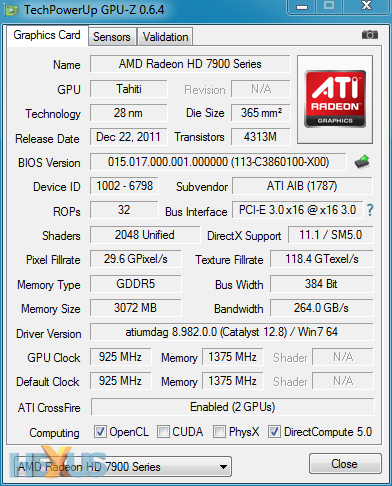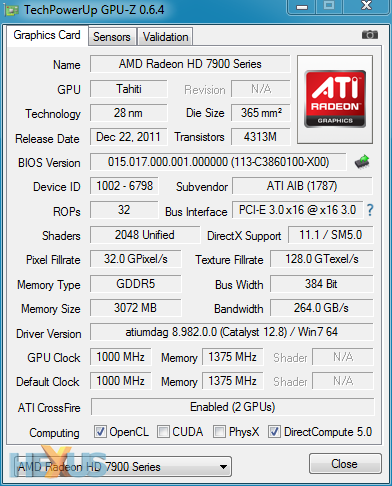Test Methodology
PowerColor HD 7990 Devil 13 standard specification |
PowerColor HD 7990 Devil 13 turbo specification |
|---|---|
 |
 |
GPU Comparisons |
|||||||
|---|---|---|---|---|---|---|---|
| Graphics Card | GPU Clock (MHz) |
Stream Processors |
Shader Clock (MHz) |
Memory Clock (MHz) |
Memory Bus (bits) |
Graphics Driver | |
| PowerColor HD 7990 Devil 13 (6,144MB) | 925 / 1,000 | 4,096 | 925 / 1,000 | 5,500 | 384 | Catalyst 12.8 | |
| Sapphire Radeon HD 7970 (3,072MB) | 925 | 2,048 | 925 | 5,500 | 384 | Catalyst 12.7 beta | |
| Sapphire Radeon HD 7950 Vapor-X (3,072MB) | 950 | 1,792 | 950 | 5,000 | 384 | Catalyst 12.8 | |
| Sapphire Radeon HD 7950 (3,072MB) | 800 | 1,792 | 800 | 5,000 | 384 | Catalyst 12.7 beta | |
| PowerColor HD 7870 Vortex II (2,048MB) | 1,150 | 1,280 | 1,150 | 5,000 | 256 | Catalyst 12.7 beta | |
| Sapphire Radeon HD 7870 (2,048MB) | 1,000 | 1,280 | 1,000 | 4,800 | 256 | Catalyst 12.7 beta | |
| Gigabyte GeForce GTX 690 (4,096MB) | 915+ | 3,072 | 915+ | 6,008 | 256 | GeForce 306.02 beta | |
| EVGA GeForce GTX 680 (2,048MB) | 1,006+ | 1,536 | 1,006+ | 6,008 | 256 | GeForce 305.37 beta | |
| ASUS GeForce GTX 670 (2,048MB) | 915+ | 1,344 | 915+ | 6,008 | 256 | GeForce 305.37 beta | |
| Gigabyte GeForce GTX 660 Ti (2,048MB) | 1,033+ | 1,344 | 1,033+ | 6,008 | 192 | GeForce 305.37 beta | |
HEXUS High-End Test Bench |
||||||||||||
|---|---|---|---|---|---|---|---|---|---|---|---|---|
| Processor | Intel Core i7-3770K (3.50GHz, 8MB cache, quad-core) | |||||||||||
| CPU Cooler | Intel reference E97378-001 | |||||||||||
| Motherboard | Gigabyte GA-Z77X-UD5H | |||||||||||
| Memory | 8GB G.Skill TridentX (2x4GB) DDR3 @ 2,400MHz | |||||||||||
| Power Supply | Corsair AX750W | |||||||||||
| Storage Device | Samsung 830 Series 256GB SSD | |||||||||||
| Optical Drive | Generic 24x DVD-RW | |||||||||||
| Chassis | Corsair Graphite Series 600T | |||||||||||
| Monitor | Dell 30in 3007WFP | |||||||||||
| Operating system | Windows 7 Ultimate (64-bit, SP1) | |||||||||||
HEXUS High-End Benchmark Suite |
||
|---|---|---|
| 3D Benchmarks | Mode and Resolutions | Quality Settings |
| 3DMark 11 | DX11 at 1,280x720 and 1,920x1,080 | Performance and Extreme Presets |
| Aliens vs. Predator | DX11 at 1,920x1,080 and 2,560x1,600 | 4xAA, 16xAF, Maximum Image Quality |
| Batman: Arkham City | DX11 at 1,920x1,080 and 2,560x1,600 | 8xMSAA, Extreme Preset |
| Battlefield 3 | DX11 at 1,920x1,080 and 2,560x1,600 | 4xMSAA, 16xAF, Ultra Preset |
| Crysis 2 | DX11 at 1,920x1,080 and 2,560x1,600 | 4xAA, Ultra Preset, DX11 and High-Res Textures |
| DiRT Showdown | DX11 at 1,920x1,080 and 2,560x1,600 | 4xMSAA, Ultra Preset |
| LuxMark 2.0 | OpenCL GPUs-only | Sala (488,000+ triangles) and Room (2,000,000+ triangles) |
| General Benchmarks | Description | |
| Power Consumption | To emulate real-world usage scenarios, we record mains power draw both when idle and while playing Batman: Arkham City | |
| Temperature | To emulate real-world usage scenarios, we record GPU core temperature both when idle and while playing Batman: Arkham City | |
| Noise | A PCE-318 meter is used to record noise levels when idle and while playing Batman: Arkham City | |
Notes
In the interests of fairness, any GPU vendor-specific technologies are disabled during benchmarking. For example, NVIDIA-exclusive features such as PhysX in Batman: Arkham City and the Bokeh Filter in Just Cause 2 are not enabled.
To get a complete picture of what the Devil 13 can do, we've benchmarked the card in both available states; standard (925MHz) and turbo (1,000MHz). Of course, what matters here is whether or not PowerColor's creation has the cojones to beat a GeForce GTX 690. To find out, we've also benchmarked NVIDIA's card using the latest available drives.









